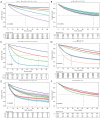Incidence, prognostic factors and survival in bladder cancer patients: a population-based study
- PMID: 36093535
- PMCID: PMC9459577
- DOI: 10.21037/tcr-22-46
Incidence, prognostic factors and survival in bladder cancer patients: a population-based study
Abstract
Background: The aim of this study was to investigate the incidence, epidemiologic characteristics, prognostic factors and survival of patients with bladder cancer.
Methods: Bladder cancer patients diagnosed between 2010 and 2015 were identified from the Surveillance, Epidemiology, and End Results (SEER) database. Univariate and multivariate Cox proportional hazards regression analyses were used to identify the independent prognostic factors for overall survival. Kaplan-Meier survival analysis and nomogram analysis were constructed based on the identified independent prognostic factors.
Results: A total of 95,329 eligible bladder cancer patients were included in this study. Eight independent risk factors, including age, histologic type, race, tumor, node and metastasis (TNM) stage, American Joint Committee on Cancer (AJCC) stage, surgery, tumor metastasis and summary stage, were recognized by using multivariate logistic regression models. By comprising these factors, a predictive nomogram was constructed to predict the 1-, 3-, and 5-year overall survival possibilities. The concordance index and calibration curve showed that the nomogram had robust and accurate performance.
Conclusions: Bladder cancer is the most common cancer of the urinary system, but the overall incidence has been decreasing yearly since 1992. Our results demonstrate eight factors significantly associated with overall survival in bladder cancer patients. Based on these factors, we established and validated a nomogram, which has the potential to provide an individualized prediction of overall survival in patients with bladder cancer.
Keywords: Bladder cancer (BC); Surveillance, Epidemiology, and End Results (SEER); multivariate; overall survival (OS).
2022 Translational Cancer Research. All rights reserved.
Conflict of interest statement
Conflicts of Interest: All authors have completed the ICMJE uniform disclosure form (available at https://tcr.amegroups.com/article/view/10.21037/tcr-22-46/coif). The authors have no conflicts of interest to declare.
Figures






Similar articles
-
Development and validation of a prognostic nomogram for predicting overall survival in patients with primary bladder sarcoma: a SEER-based retrospective study.BMC Urol. 2021 Nov 25;21(1):162. doi: 10.1186/s12894-021-00929-x. BMC Urol. 2021. PMID: 34823525 Free PMC article.
-
Prognostic Factors and a Nomogram Predicting Overall Survival and Cancer-Specific Survival for Patients with Collecting Duct Renal Cell Carcinoma.Biomed Res Int. 2021 Nov 11;2021:6736008. doi: 10.1155/2021/6736008. eCollection 2021. Biomed Res Int. 2021. PMID: 34805402 Free PMC article.
-
Marital Status and Prognostic Nomogram for Bladder Cancer With Distant Metastasis: A SEER-Based Study.Front Oncol. 2020 Oct 27;10:586458. doi: 10.3389/fonc.2020.586458. eCollection 2020. Front Oncol. 2020. PMID: 33194738 Free PMC article.
-
Development and Validation of Prognostic Nomograms to Predict Overall and Cancer-Specific Survival for Patients with Adenocarcinoma of the Urinary Bladder: A Population-Based Study.J Invest Surg. 2022 Jan;35(1):30-37. doi: 10.1080/08941939.2020.1812776. Epub 2020 Aug 27. J Invest Surg. 2022. PMID: 32851885 Clinical Trial.
-
Development and validation of a Surveillance, Epidemiology, and End Results (SEER)-based prognostic nomogram for predicting survival in gastric cancer with multi-organ metastases.Transl Cancer Res. 2022 Jun;11(6):1534-1551. doi: 10.21037/tcr-21-2569. Transl Cancer Res. 2022. PMID: 35836507 Free PMC article.
Cited by
-
Development and validation of a novel nomogram model for predicting the survival of patients with T2-4a, N0-x, M0 bladder cancer: a retrospective cohort study.Am J Clin Exp Urol. 2023 Dec 15;11(6):500-515. eCollection 2023. Am J Clin Exp Urol. 2023. PMID: 38148935 Free PMC article.
References
LinkOut - more resources
Full Text Sources
